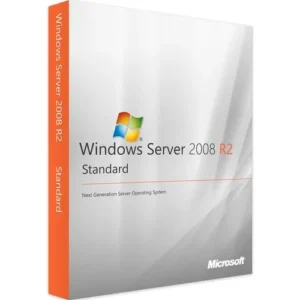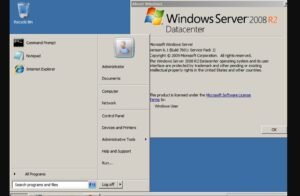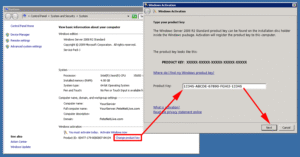Windows Server 2008 R2 Standard for windows
What's new

Sure! Here's a comprehensive overview of Windows Server 2008 R2 Standard, including key features, system requirements, lifecycle details, and more:
🌐 Windows Server 2008 R2 Standard - Full Details
📅 Release Information
-
Released: October 22, 2009
-
Build: 7600
-
Version: NT 6.1 (same as Windows 7)
-
Editions Available: Standard, Enterprise, Datacenter, Web, Itanium, Foundation
⚙️ Key Features of Windows Server 2008 R2 Standard
🖥️ Core Enhancements
-
64-bit Only: First Windows Server OS to be 64-bit only
-
Improved Scalability & Performance over Server 2008
-
Updated UI: Windows 7-style interface
🧱 Active Directory
-
Active Directory Recycle Bin – Restore deleted objects
-
Active Directory Administrative Center – More user-friendly management
-
Managed Service Accounts
📡 Networking Improvements
-
DirectAccess – Seamless, always-on VPN-like remote access
-
BranchCache – Local caching of frequently accessed data
-
IPv6 Enhancements
💻 Remote Access & Desktop Services
-
Remote Desktop Services (RDS) – Successor to Terminal Services
-
RemoteApp – Publish individual apps instead of full desktops
-
VDI (Virtual Desktop Infrastructure) support
🔒 Security Features
-
AppLocker – Application whitelisting tool
-
BitLocker Enhancements – Encryption improvements
-
Read-Only Domain Controller (RODC) support
🔧 Management Tools
-
Server Manager Enhancements
-
PowerShell 2.0
-
Best Practices Analyzer (BPA)
🖥️ Hardware Requirements (Minimum)
| Component | Requirement |
|---|---|
| Processor | 1.4 GHz (x64) or faster |
| RAM | 512 MB minimum (2 GB or more recommended) |
| Disk Space | 32 GB or more |
| Display | Super VGA (800x600) or higher resolution |
📜 Licensing & Role Limitations (Standard Edition)
-
Maximum RAM Supported: 32 GB
-
Maximum Logical Processors: 4
-
VMs allowed with license: 1 virtual instance
-
Roles supported: Full range except for some that are edition-specific (e.g., clustering limited vs Enterprise/Datacenter)
🔚 End of Life (EOL) Information
| Support Type | Date |
|---|---|
| Mainstream Support Ended | January 13, 2015 |
| Extended Support Ended | January 14, 2020 |
| ESU (Extended Security Updates) | Ended January 10, 2023 |
⚠️ As of now, Windows Server 2008 R2 is no longer supported by Microsoft unless you're on a special extended paid support (ESU) contract, which ended for most users in 2023.
📌 Notable Use Cases (Back in its Prime)
-
Small to medium business file and print servers
-
Domain Controllers for Active Directory
-
Hosting IIS Web Applications
-
Remote Desktop Hosting (light use)
-
Application and database hosting for legacy systems
Images




| Size | 1.87 GB |
| Version | 7601 |
| Requirements | 🖥️ Hardware Requirements (Minimum) Component Requirement Processor 1.4 GHz (x64) or faster RAM 512 MB minimum (2 GB or more recommended) Disk Space 32 GB or more Display Super VGA (800x600) or higher resolution |
| Downloads | 10+ M |
Description

Sure! Here’s a comprehensive overview of Windows Server 2008 R2 Standard, including key features, system requirements, lifecycle details, and more:
🌐 Windows Server 2008 R2 Standard – Full Details
📅 Release Information
-
Released: October 22, 2009
-
Build: 7600
-
Version: NT 6.1 (same as Windows 7)
-
Editions Available: Standard, Enterprise, Datacenter, Web, Itanium, Foundation
⚙️ Key Features of Windows Server 2008 R2 Standard
🖥️ Core Enhancements
-
64-bit Only: First Windows Server OS to be 64-bit only
-
Improved Scalability & Performance over Server 2008
-
Updated UI: Windows 7-style interface
🧱 Active Directory
-
Active Directory Recycle Bin – Restore deleted objects
-
Active Directory Administrative Center – More user-friendly management
-
Managed Service Accounts
📡 Networking Improvements
-
DirectAccess – Seamless, always-on VPN-like remote access
-
BranchCache – Local caching of frequently accessed data
-
IPv6 Enhancements
💻 Remote Access & Desktop Services
-
Remote Desktop Services (RDS) – Successor to Terminal Services
-
RemoteApp – Publish individual apps instead of full desktops
-
VDI (Virtual Desktop Infrastructure) support
🔒 Security Features
-
AppLocker – Application whitelisting tool
-
BitLocker Enhancements – Encryption improvements
-
Read-Only Domain Controller (RODC) support
🔧 Management Tools
-
Server Manager Enhancements
-
PowerShell 2.0
-
Best Practices Analyzer (BPA)
🖥️ Hardware Requirements (Minimum)
| Component | Requirement |
|---|---|
| Processor | 1.4 GHz (x64) or faster |
| RAM | 512 MB minimum (2 GB or more recommended) |
| Disk Space | 32 GB or more |
| Display | Super VGA (800×600) or higher resolution |
📜 Licensing & Role Limitations (Standard Edition)
-
Maximum RAM Supported: 32 GB
-
Maximum Logical Processors: 4
-
VMs allowed with license: 1 virtual instance
-
Roles supported: Full range except for some that are edition-specific (e.g., clustering limited vs Enterprise/Datacenter)
🔚 End of Life (EOL) Information
| Support Type | Date |
|---|---|
| Mainstream Support Ended | January 13, 2015 |
| Extended Support Ended | January 14, 2020 |
| ESU (Extended Security Updates) | Ended January 10, 2023 |
⚠️ As of now, Windows Server 2008 R2 is no longer supported by Microsoft unless you’re on a special extended paid support (ESU) contract, which ended for most users in 2023.
📌 Notable Use Cases (Back in its Prime)
-
Small to medium business file and print servers
-
Domain Controllers for Active Directory
-
Hosting IIS Web Applications
-
Remote Desktop Hosting (light use)
-
Application and database hosting for legacy systems
![]()
Download links
How to install Windows Server 2008 R2 Standard for windows?
1. Download the ZIP file.
2. Install the Softwares Installer application
3. Open the application and click on "Install Softwares".
4. Find the folder where the downloaded ZIP is located and select it.
5. Follow the steps that appear on the screen.